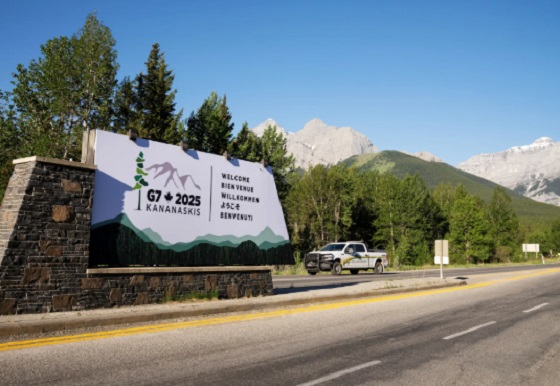Uncategorized
Migrants in southern Mexico set sights on town near Gulf
MATIAS ROMERO, Mexico — The main caravan of Central American migrants spent a rain-drenched night outside before continuing their slow walk through southern Mexico, on a path that is taking them toward the Gulf of Mexico and the U.S. border.
It remains unclear whether the caravan — the first of four that has formed — would make a turn east to Mexico City, or try to reach the nearest and most dangerous stretch of border, which lies almost directly north.
It also remained unclear how many would make it; 20 days of scorching heat, constant walking, chills, rain and illness had taken their toll. Mexico’s Interior Department said Thursday nearly 3,000 of the migrants have applied for refuge in Mexico and hundreds more have returned home. At its peak, the caravan had about 7,000 people.
Honduran migrant Saul Guzman, 48, spent the night under a tin roof in the Oaxaca state town of Matias Romero with his son Dannys, 12, before setting out for the town of Donaji, 30 miles (47
“I have been through a lot,” said Guzman. “I want to spend my time differently, not in poverty.”
The only thing he left behind in his hometown is a coffin, either for his mother, who suffers dementia, “or for me, if I don’t make it,” Guzman said.
The migrants had already made a grueling 40-mile (
Cesar Caraca, a 26-year-old migrant from Honduras, said he killed a poisonous coral snake in the brush near the site at the entrance to Matias Romero where they set up camp Thursday.
“This bites a child and kills him,” Caraca said. The meter-long snake coupled with complaints of bad smells and poor lighting led some migrants to move to an empty hotel that had been damaged by a 2017 earthquake.
The migrants have not said what route they intend to take northward or where on the U.S. border they plan to reach, but Veracruz would take them toward the Texas border. Another large caravan early this year passed through Veracruz but then veered back toward Mexico City and eventually tried to head to Tijuana in the far northwest. Few made it.
Immigration agents and police in Mexico are nibbling at the edges of two caravans currently making their way through southern Mexico.
While authorities haven’t directly targeted the main caravan of about 4,000 migrants, a second, smaller caravan about 200 miles behind the first group appeared to be more leaderless, get less press attention and be more vulnerable.
A federal official who was not authorized to be quoted by name said 153 migrants in the second caravan were detained Wednesday during highway inspections in the southern state of Chiapas, a short distance from the Guatemalan border. While the precise size of the second caravan is unclear, that could be equivalent to about 10
And there was also pressure on the first caravan. Not only did the hoped-for buses not arrive, but federal police began pulling freight trucks over and forcing migrants off, saying their habit of clinging to the tops or sides of the trucks was dangerous.
“Get off! Get off!” police officer Benjamin Grajeda shouted to a group of migrants clinging to the side of a truck outside Juchitan. “You can ride inside, but not on the outside.”
At other points along the route, police have forced overloaded pickups to disgorge migrants. On previous days, they have ordered passenger vans to stop transporting migrants.
But U.S. President Donald Trump ramped up his pre-election focus on the caravan and others behind it, talking of creating a U.S. military force on the border that would outnumber the migrants, many of them women and children.
“As far as the caravan is concerned, our military is out,” Trump said. “We have about 5,800. We’ll go up to anywhere between 10,000 and 15,000 military personnel on top of Border Patrol, ICE and everybody else at the border.”
A third band of about 500 from El Salvador made it to Guatemala, and a fourth group of about 700 set out from the Salvadoran capital Wednesday.
Similar caravans have occurred regularly over the years and passed largely unnoticed, but Trump has focused on the latest marchers seeking to make border security a hot-button issue in next week’s midterm elections.
__
Associated Press writer Peter Orsi in Mexico City contributed to this report.
Sonia Perez D., The Associated Press
Uncategorized
CNN’s Shock Climate Polling Data Reinforces Trump’s Energy Agenda


From the Daily Caller News Foundation
As the Trump administration and Republican-controlled Congress move aggressively to roll back the climate alarm-driven energy policies of the Biden presidency, proponents of climate change theory have ramped up their scare tactics in hopes of shifting public opinion in their favor.
But CNN’s energetic polling analyst, the irrepressible Harry Enten, says those tactics aren’t working. Indeed, Enten points out the climate alarm messaging which has permeated every nook and cranny of American society for at least 25 years now has failed to move the public opinion needle even a smidgen since 2000.
Appearing on the cable channel’s “CNN News Central” program with host John Berman Thursday, Enten cited polling data showing that just 40% of U.S. citizens are “afraid” of climate change. That is the same percentage who gave a similar answer in 2000.
Dear Readers:
As a nonprofit, we are dependent on the generosity of our readers.
Please consider making a small donation of any amount here.
Thank you!
Enten’s own report is an example of this fealty. Saying the findings “kind of boggles the mind,” Enten emphasized the fact that, despite all the media hysteria that takes place in the wake of any weather disaster or wildfire, an even lower percentage of Americans are concerned such events might impact them personally.
“In 2006, it was 38%,” Enten says of the percentage who are even “sometimes worried” about being hit by a natural disaster, and adds, “Look at where we are now in 2025. It’s 32%, 38% to 32%. The number’s actually gone down.”
In terms of all adults who worry that a major disaster might hit their own hometown, Enten notes that just 17% admit to such a concern. Even among Democrats, whose party has been the major proponent of climate alarm theory in the U.S., the percentage is a paltry 27%.
While Enten and Berman both appear to be shocked by these findings, they really aren’t surprising. Enten himself notes that climate concerns have never been a driving issue in electoral politics in his conclusion, when Berman points out, “People might think it’s an issue, but clearly not a driving issue when people go to the polls.”
“That’s exactly right,” Enten says, adding, “They may worry about in the abstract, but when it comes to their own lives, they don’t worry.”
This reality of public opinion is a major reason why President Donald Trump and his key cabinet officials have felt free to mount their aggressive push to end any remaining notion that a government-subsidized ‘energy transition’ from oil, gas, and coal to renewables and electric vehicles is happening in the U.S. It is also a big reason why congressional Republicans included language in the One Big Beautiful Bill Act to phase out subsidies for those alternative energy technologies.
It is key to understand that the administration’s reprioritization of energy and climate policies goes well beyond just rolling back the Biden policies. EPA Administrator Lee Zeldin is working on plans to revoke the 2010 endangerment finding related to greenhouse gases which served as the foundation for most of the Obama climate agenda as well.
If that plan can survive the inevitable court challenges, then Trump’s ambitions will only accelerate. Last year’s elimination of the Chevron Deference by the Supreme Court increases the chances of that happening. Ultimately, by the end of 2028, it will be almost as if the Obama and Biden presidencies never happened.
The reality here is that, with such a low percentage of voters expressing concerns about any of this, Trump and congressional Republicans will pay little or no political price for moving in this direction. Thus, unless the polls change radically, the policy direction will remain the same.
David Blackmon is an energy writer and consultant based in Texas. He spent 40 years in the oil and gas business, where he specialized in public policy and communications.
Uncategorized
Kananaskis G7 meeting the right setting for U.S. and Canada to reassert energy ties


Energy security, resilience and affordability have long been protected by a continentally integrated energy sector.
The G7 summit in Kananaskis, Alberta, offers a key platform to reassert how North American energy cooperation has made the U.S. and Canada stronger, according to a joint statement from The Heritage Foundation, the foremost American conservative think tank, and MEI, a pan-Canadian research and educational policy organization.
“Energy cooperation between Canada, Mexico and the United States is vital for the Western World’s energy security,” says Diana Furchtgott-Roth, director of the Center for Energy, Climate and Environment and the Herbert and Joyce Morgan Fellow at the Heritage Foundation, and one of America’s most prominent energy experts. “Both President Trump and Prime Minister Carney share energy as a key priority for their respective administrations.
She added, “The G7 should embrace energy abundance by cooperating and committing to a rapid expansion of energy infrastructure. Members should commit to streamlined permitting, including a one-stop shop permitting and environmental review process, to unleash the capital investment necessary to make energy abundance a reality.”
North America’s energy industry is continentally integrated, benefitting from a blend of U.S. light crude oil and Mexican and Canadian heavy crude oil that keeps the continent’s refineries running smoothly.
Each day, Canada exports 2.8 million barrels of oil to the United States.
These get refined into gasoline, diesel and other higher value-added products that furnish the U.S. market with reliable and affordable energy, as well as exported to other countries, including some 780,000 barrels per day of finished products that get exported to Canada and 1.08 million barrels per day to Mexico.
A similar situation occurs with natural gas, where Canada ships 8.7 billion cubic feet of natural gas per day to the United States through a continental network of pipelines.
This gets consumed by U.S. households, as well as transformed into liquefied natural gas products, of which the United States exports 11.5 billion cubic feet per day, mostly from ports in Louisiana, Texas and Maryland.
“The abundance and complementarity of Canada and the United States’ energy resources have made both nations more prosperous and more secure in their supply,” says Daniel Dufort, president and CEO of the MEI. “Both countries stand to reduce dependence on Chinese and Russian energy by expanding their pipeline networks – the United States to the East and Canada to the West – to supply their European and Asian allies in an increasingly turbulent world.”
Under this scenario, Europe would buy more high-value light oil from the U.S., whose domestic needs would be back-stopped by lower-priced heavy oil imports from Canada, whereas Asia would consume more LNG from Canada, diminishing China and Russia’s economic and strategic leverage over it.
* * *
The MEI is an independent public policy think tank with offices in Montreal, Ottawa, and Calgary. Through its publications, media appearances, and advisory services to policymakers, the MEI stimulates public policy debate and reforms based on sound economics and entrepreneurship.
As the nation’s largest, most broadly supported conservative research and educational institution, The Heritage Foundation has been leading the American conservative movement since our founding in 1973. The Heritage Foundation reaches more than 10 million members, advocates, and concerned Americans every day with information on critical issues facing America.
-

 Opinion1 day ago
Opinion1 day agoPreston Manning: Three Wise Men from the East, Again
-

 Addictions1 day ago
Addictions1 day agoWhy B.C.’s new witnessed dosing guidelines are built to fail
-

 Business1 day ago
Business1 day agoCarney Liberals quietly award Pfizer, Moderna nearly $400 million for new COVID shot contracts
-

 Business1 day ago
Business1 day agoMark Carney’s Fiscal Fantasy Will Bankrupt Canada
-

 Uncategorized2 days ago
Uncategorized2 days agoCNN’s Shock Climate Polling Data Reinforces Trump’s Energy Agenda
-

 National13 hours ago
National13 hours agoCanada’s immigration office admits it failed to check suspected terrorists’ background
-

 conflict13 hours ago
conflict13 hours agoTrump’s done waiting: 50-day ultimatum for Putin to end Ukraine war
-

 COVID-191 day ago
COVID-191 day agoTrump DOJ dismisses charges against doctor who issued fake COVID passports






